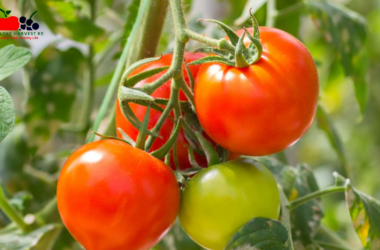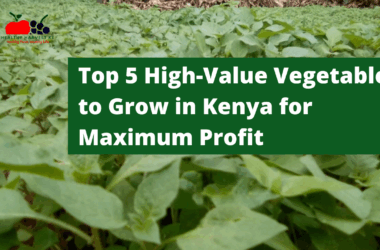So you’re thinking about jumping into avocado farming in Kenya? Smart move. Kenya’s not just leading Africa in avocado production—it’s making serious waves globally, ranking seventh worldwide with production hitting 417,000 tonnes in 2022.
What’s driving this green gold rush? Perfect growing conditions, strategic government backing, and a global appetite that just keeps growing. If you’re looking for a crop that offers serious earning potential with staying power, you’ve found it.
This guide walks you through everything you need to know to start and scale a profitable avocado farm in Kenya, with special focus on tapping into those lucrative export markets where the real money is made.
Why Avocado Farming in Kenya Makes Financial Sense
Let’s talk cash first—because that’s what matters. The numbers tell a compelling story:
- Price differential: While local markets typically offer Ksh 10-20 per fruit, export markets provide approximately Ksh 150 per kilogram
- Production capacity: A mature Hass avocado tree can produce up to 1,000 fruits per season
- Longevity: Avocado trees remain productive for about 20 years, giving you decades of returns on your initial investment
- Global demand: Kenya’s strategic position as Africa’s leading producer creates opportunities to capitalize on expanding international markets, especially in China and the Middle East
The math is simple: even a modest-sized orchard can generate substantial, consistent income over many years when you’re selling to the right markets.
Getting Started: Location and Land Requirements
Before you plant a single seedling, you need to get your location right. Kenya offers several prime avocado-growing regions:
Top Production Regions
- Central Kenya: Traditional avocado heartland with established infrastructure
- Bomet County: Emerging as the leading avocado hub in the South Rift region
- Western Kenya: Including Bungoma, Kisumu, and other Nyanza counties—previously overlooked but now recognized as having excellent potential
What to Look for in Your Land
Your farm’s success starts with selecting the right plot:
- Climate: Avocados thrive with well-distributed annual rainfall of approximately 1600mm
- Soil: Well-draining soils with pH 5.5-6.5 are ideal
- Altitude: Different varieties perform best at different elevations (Hass: 1,500-2,100m; Fuerte: 1,200-1,800m)
- Access: Consider proximity to packing facilities and transportation routes, especially if targeting export markets
Making the Climate Work for You
If you’re transitioning from other crops like coffee (which is facing climate challenges), avocados offer greater resilience to changing weather patterns. They’re adaptable to different rainfall conditions, though consistent moisture is key for optimal production.
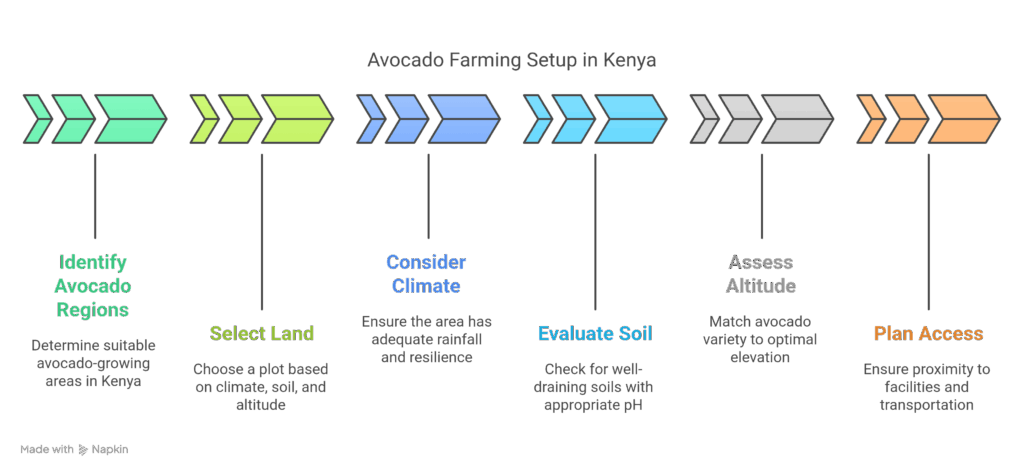
Selecting the Right Avocado Varieties
Kenya grows over 40 avocado varieties, but not all are created equal when it comes to profitability and export potential.
Hass: The Export Champion
The Hass variety dominates Kenya’s export market, and for good reason:
- Superior shelf life (critical for shipping to international markets)
- Rich buttery texture and consistent quality that international consumers prefer
- Purplish-brown skin when ripe, making ripeness easy to identify
- Higher price point in international markets
Other Commercial Varieties
While Hass should be your primary focus for exports, consider these varieties as complementary options:
- Fuerte: Green-skinned with good oil content, popular in certain markets
- Pinkerton: Large fruit size with small seed, good yield potential
- Reed: Large round fruit with smooth texture, later season maturity
Smart Variety Planning
For maximum profitability, commercial farmers should:
- Plant 70-80% Hass for export focus
- Include some early and late season varieties to extend harvest windows
- Consider local market preferences for secondary varieties
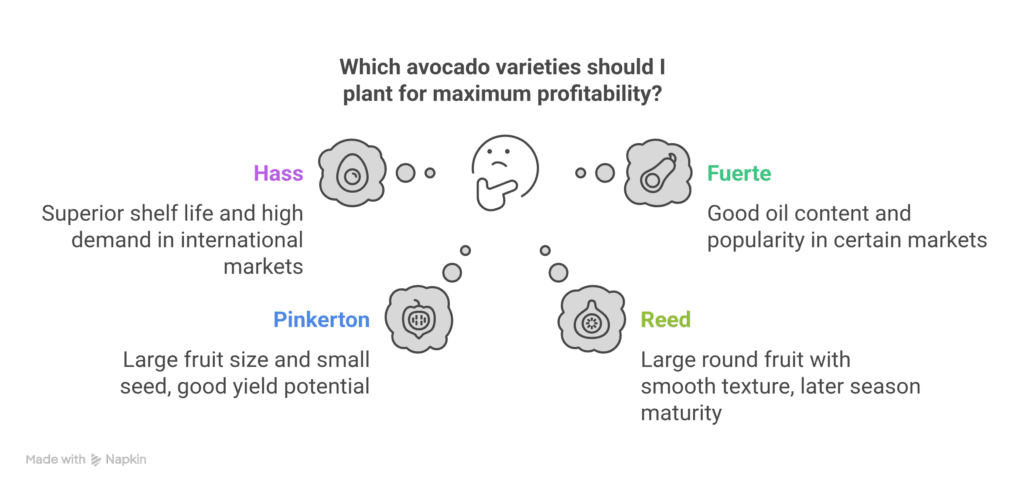
Sourcing Quality Seedlings
Your trees are only as good as the seedlings you start with. Here’s how to ensure quality:
Certified Sources
- KALRO (Kenya Agricultural and Livestock Research Organisation): Has established seedling multiplication centers across Kenya, including the Kibos center in Kisumu
- KEPHIS-certified nurseries: Ensures seedlings meet quality standards for international markets
- County government programs: Some counties like Bomet offer subsidized quality seedlings
What to Look for in Seedlings
- Certification tags verifying variety authenticity
- Healthy root systems with no signs of disease
- 8-12 months old for optimal transplanting success
- Grafted varieties (not seedling-grown) for consistent quality
Planning Your Purchase
KALRO allows farmers to place orders for seedlings with payment terms of up to 60 days, making it easier to manage startup costs. They’re targeting production of 320,000 seedlings annually at centers across the country.
Planting and Orchard Establishment
Getting your orchard established correctly will determine your success for the next two decades.
Land Preparation
- Clear the land of weeds and competing vegetation
- Test soil and amend as needed to reach optimal pH
- Dig planting holes 60cm x 60cm x 60cm
- Mix topsoil with manure and phosphorus fertilizer before backfilling
Planting Layout and Spacing
For commercial production aimed at export markets:
- Spacing: 7m x 7m for Hass (about 200 trees per hectare)
- Row orientation: North-south rows maximize sunlight exposure
- Access planning: Leave adequate space for farm equipment and harvest activities
Initial Care
- Water newly planted seedlings immediately and regularly
- Mulch around the base to conserve moisture and suppress weeds
- Protect young trees from livestock and wildlife with guards
- Consider intercropping with short-term crops in the first 2-3 years
Orchard Management for Maximum Yields
To hit those 1,000 fruits per tree, you need to nail your management practices.
Irrigation Systems
While avocados can survive on rainfall alone in some regions, supplemental irrigation dramatically improves yield and fruit quality:
- Drip irrigation is most efficient and water-conserving
- Young trees need 20-30 liters weekly
- Mature trees require 50-75 liters weekly during dry periods
- Critical irrigation periods: flowering, fruit set, and early fruit development
Fertilization Program
Develop a science-based feeding program:
- Soil testing determines specific needs
- Nitrogen is crucial during vegetative growth
- Phosphorus and potassium support flowering and fruiting
- Micronutrients like zinc and boron prevent deficiencies
- Split applications throughout the year for better uptake
Pruning Techniques
Proper pruning increases yields and fruit quality:
- Formative pruning in years 1-3 establishes strong framework
- Maintenance pruning removes dead wood and maintains tree height
- Thin dense canopy to allow light penetration
- Post-harvest pruning prepares trees for next season
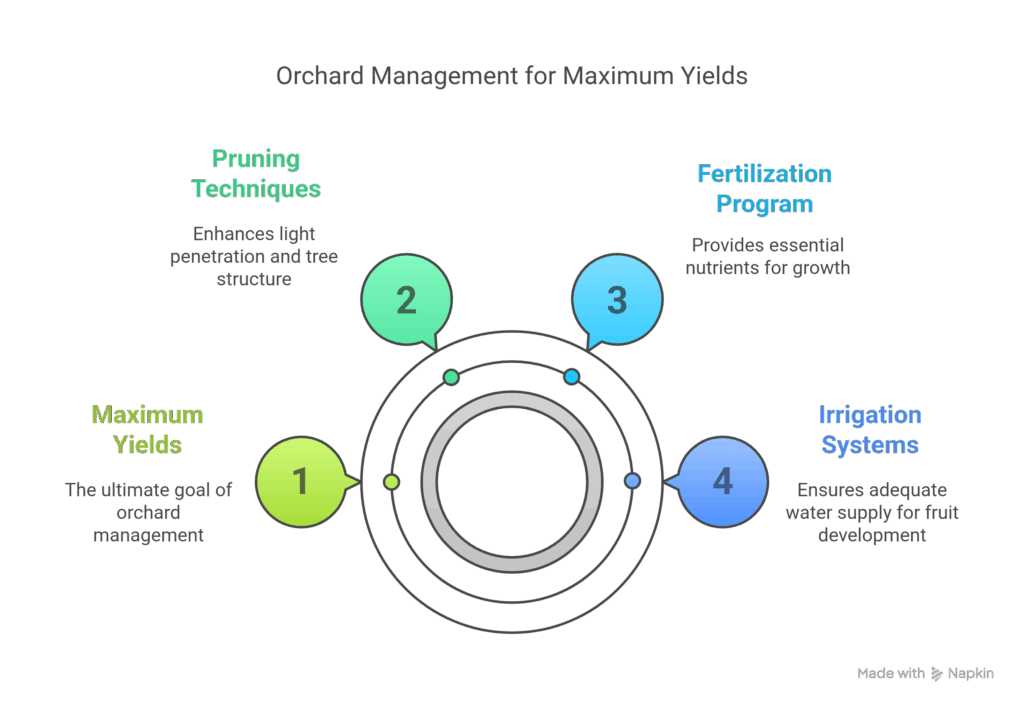
Pest and Disease Management
Effective pest and disease control is essential for producing export-quality fruit.
Common Pests
Spider Mites
- Signs: Brown spots on leaves and fruits, increased leaf fall
- Control: Proper pruning, adequate irrigation, washing leaves with high-pressure hoses
- Recovery: Intensify irrigation and fertilization for heavily infested trees
Insect Borers
- Signs: Tunneling damage, weakened branches
- Control: Identify and remove infected branches promptly
Scales
- Impact: While they don’t cause internal fruit damage, their presence on skin can lead to export rejection
- Natural control: Parasitic wasps and ladybirds help manage populations
Fruit Flies
- Damage: Lay eggs under fruit skin, causing lesions and premature fruit drop
- Management: Orchard sanitation, monitoring, and strategic use of baits
Major Diseases
Avocado Root Rot
- Cause: Phytophthora cinnamomi, a soil-borne pathogen
- Impact: Attacks root system, impairs water/nutrient uptake, potentially fatal
- Prevention: Well-draining soils, resistant rootstocks, careful irrigation management
Stem End Rot
- Cause: Multiple pathogens including Lasiodiplodi theobromae
- Management: Avoid fruit injury during harvest, reduce time between harvesting and processing, apply appropriate fungicides
Anthracnose
- Challenge: Often misidentified as scab or bacterial canker
- Approach: Accurate diagnosis through consultation with plant pathologists or agronomists
Integrated Pest Management (IPM)
For export markets, chemical controls must be used carefully:
- Follow MRL (Maximum Residue Limit) guidelines for export markets
- Document all applications for traceability
- Incorporate biological controls where possible
- Time applications to protect beneficial insects
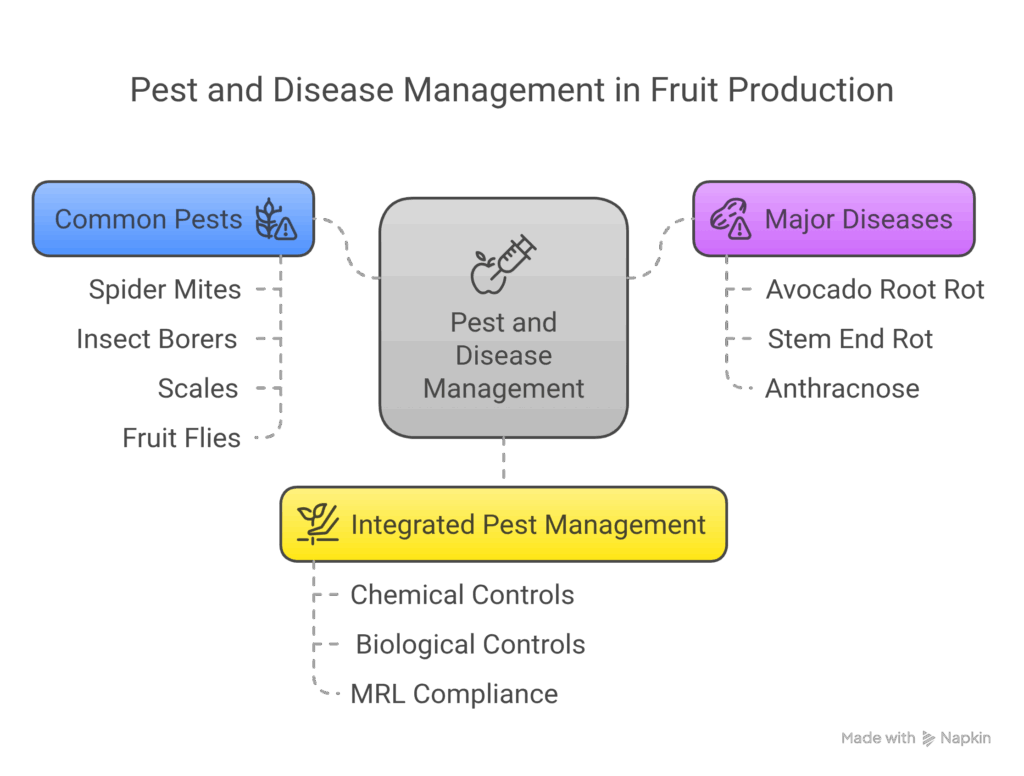
Harvesting for Export Markets
Timing and technique are everything when harvesting for picky international buyers.
Determining Maturity
For Hass avocados:
- 9-12 months from flowering to harvest maturity
- Skin begins changing from green to purplish color
- Dry matter content reaches 23-24% (professional testing available through export companies)
Harvesting Methods
- Use clippers to cut stems 5-10mm from fruit
- Never pull fruits from trees
- Harvest during cool morning hours
- Handle fruits carefully to avoid bruising
- Use clean, padded collection crates
Post-Harvest Handling
- Move harvested fruit to shade immediately
- Don’t wash fruits in the field
- Transport to packing facility within hours of harvest
- Maintain temperature control throughout the chain
Accessing Export Markets
This is where your farming operation transforms from good to great.
Export Market Requirements
International buyers have strict standards:
- Size specifications (typically 170-350g for premium markets)
- Quality parameters (skin free of blemishes, proper maturity)
- Food safety certification (GlobalGAP, HACCP)
- Traceability systems
- Consistent supply volumes
Export Channels
You have several options to reach international markets:
- Direct exporting: Requires significant volume and infrastructure
- Export companies: Partner with established exporters who handle logistics
- Farmer cooperatives: Pool resources with other growers
- Contract farming: Produce under agreement for exporters
Value Addition Opportunities
Beyond fresh fruit exports:
- Avocado oil processing
- Cosmetic product ingredients
- Frozen avocado products
- Organic certification for premium pricing
Cold Chain Infrastructure
Counties like Bomet are investing in modern packhouses with cold storage facilities:
- The Bomet County Government is building a Sh180 million state-of-the-art avocado packhouse
- These facilities enable cleaning, sorting, waxing, grading, and packaging
- Cold storage extends shelf life dramatically
- Eliminates exploitative middlemen from the supply chain
Financial Planning and Investment
Let’s talk money—what you’ll need to invest and what you can expect in return.
Startup Costs (Per Hectare)
- Land preparation: Ksh 30,000-50,000
- Quality seedlings (200): Ksh 70,000-100,000
- Irrigation system: Ksh 150,000-300,000
- Fencing and security: Ksh 50,000-100,000
- Initial fertilizer and amendments: Ksh 30,000-50,000
- Labor for planting: Ksh 20,000-30,000
Production Timeline and Cash Flow
- Years 1-2: Establishment phase, minimal production
- Years 3-4: Beginning commercial production
- Years 5-8: Rapidly increasing yields
- Years 8+: Full production capacity
Return on Investment
For a one-hectare Hass avocado orchard targeting export markets:
- Full production: 10-15 tons per hectare annually
- Export price: Ksh 150 per kg (conservative estimate)
- Gross revenue at full production: Ksh 1.5-2.25 million per hectare annually
- Operating costs: 35-40% of gross revenue
- Break-even: Typically year 5-6
- ROI over 20-year lifespan: 300-400%
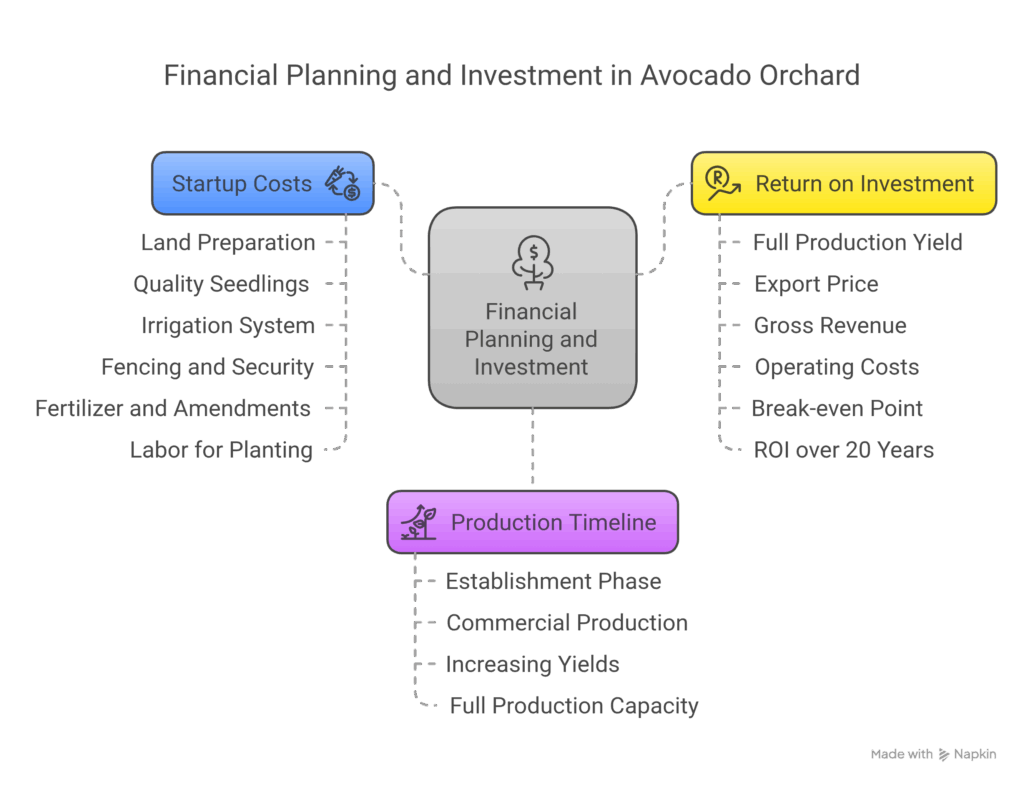
Support Programs for Aspiring Farmers
You don’t have to go it alone—Kenya has robust support systems for avocado farmers.
Government Support Through KALRO
KALRO offers comprehensive assistance:
- Research-backed cultivation guidance
- Quality seedling production
- Farmer field days and training
- Variety testing and certification
International Development Partnerships
Programs like the USAID-funded Kenya Crops and Dairy Markets Systems (KCDMS) provide:
- Enhanced farmer capacity through training
- Improved access to financial services and inputs
- Value chain connections
- Market access facilitation
The KCDMS program operates across 12 counties and has organized benchmarking trips to established avocado-producing regions like Muranga.
County Government Initiatives
Many counties offer targeted support:
- Subsidized seedling distribution
- Extension services
- Co-investment in processing infrastructure
- Market linkage programs
Conclusion: Your Next Steps
Kenya’s avocado sector offers incredible potential for aspiring farmers willing to invest in quality practices and target premium markets. With proper planning, management, and market connections, you can build a farming business that provides sustainable income for decades.
To get started:
- Research and visit potential farming locations
- Connect with KALRO and county agricultural offices
- Develop a detailed business plan with phased implementation
- Source certified quality seedlings
- Begin with manageable acreage and scale gradually
- Focus on export quality from day one
Remember: the highest returns come to those who build robust export connections and maintain unwavering quality standards. With Kenya’s position as Africa’s leading avocado producer and exporter, you’re entering an industry with proven success and tremendous future potential.
Ready to grow the green gold of Kenya’s agricultural future? Your avocado farming journey starts now.








